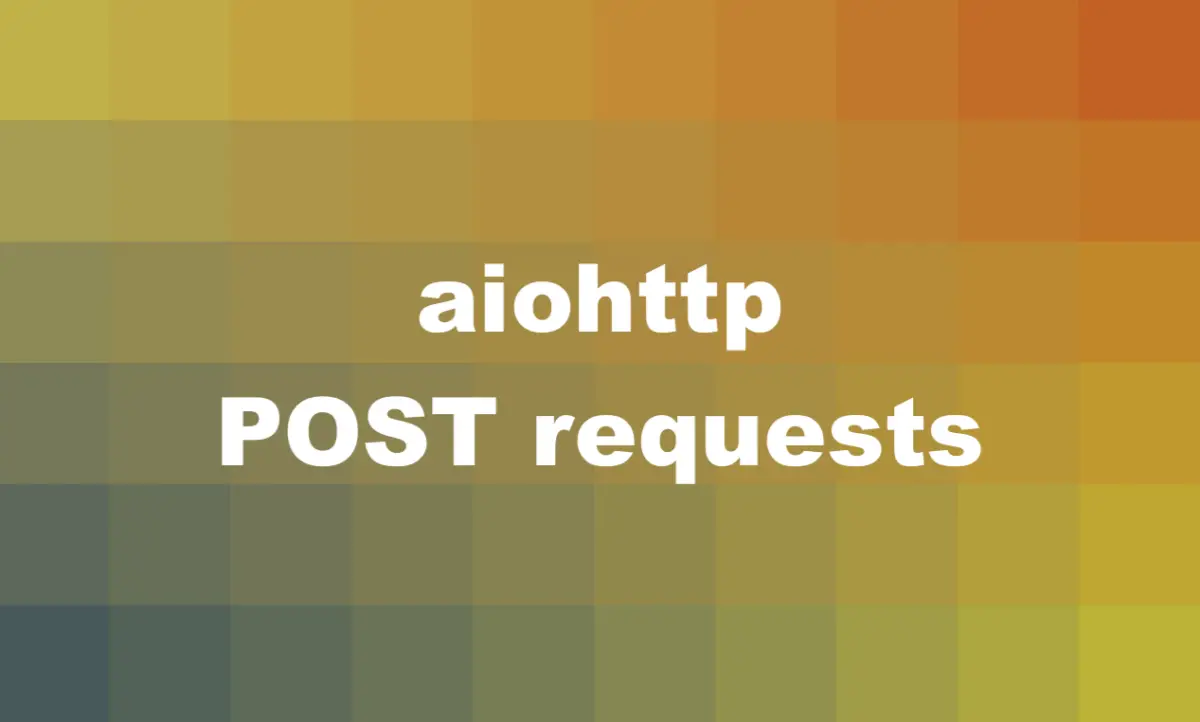
aiohttp is a modern Python library that allows you to make http requests asynchronously with the async/await syntax. In this concise and straightforward article, we’ll learn how to use this library to efficiently send POST requests to an API endpoint or a remote server. We’ll have a look at the fundamentals and then walk through a few examples of applying that knowledge in practice.
The Fundamentals
Before getting started, make sure you have aiohttp installed:
pip install aiohttpThe session.post() method
To send POST requests with aiohttp, you need to use the aiohttp.ClientSession() function to create a session object, and then call the post() method on that session object. Below is the syntax of the session.post() method:
session.post(url, *, data=None, json=None, **kwargs)The parameters are:
url: The URL of the request. It can be a string or a yarl.URL object. It is the only required parameter.data: The data to send in the request body. It can be one of the following types:bytes: A binary data object.str: A text data object. It will be encoded using UTF-8 by default.dict: A dictionary of key-value pairs. It will be encoded using theapplication/x-www-form-urlencodedcontent type by default.aiohttp.FormData: A multipart form data object. It can contain files and fields.async generator: An asynchronous generator that yields binary data chunks.file-like object: An object that supports theread()method, such as an open file or aBytesIOobject.
json: The JSON data to send in the request body. It can be any Python object that is serializable by thejsonmodule. It will be encoded using theapplication/jsoncontent type by default.**kwargs: Any other keyword arguments that are supported by theClientSession.request()method, such asheaders,params,auth,timeout, etc.
The session.post() method returns a ClientResponse object, which represents the response from the server. You can access various attributes and methods of the response object, such as status, headers, text(), json(), etc.
The session.request() method
An alternative way to make POST requests is to use the session.request() method with the first parameter is set to "POST":
session.request("POST", url, *, data=None, json=None, **kwargs)Other parameters are the same as the session.post() method.
Examples
In the following example, we’ll make some POST requests to this API endpoint:
https://api.slingacademy.com/v1/sample-data/productsYou can post information about a fictional product to it with a name (required), price (required), description (optional), and quantity (optional).
Example 1: Sending JSON data
By using the async width statement, you can create a session object and close it automatically. Below is the code:
# SlingAcademy.com
# This code uses Python 3.11.4
import asyncio
import aiohttp
# Import the pprint module to print the JSON response in a readable format
# This is a built-in module, so it does not need to be installed
from pprint import pprint
async def main(url):
# Create a session using the async with statement
async with aiohttp.ClientSession() as session:
# Make a POST request using the session.post() method
async with session.post(
url,
json={
"name": "Example Product",
"price": 99.99,
"description": "This is an example product.",
"quantity": 3,
},
) as response:
# Print the status code and the response text
print(f"Status: {response.status}")
pprint(await response.json())
# Run the main coroutine
url = "https://api.slingacademy.com/v1/sample-data/products"
asyncio.run(main(url))Output:
Status: 201
{'message': 'product submitted successfully',
'product': {'created_at': '2023-08-19T19:35:52.666168+00:00',
'description': 'This is an example product.',
'id': 'test-123',
'name': 'Example Product',
'price': 99.99,
'quantity': 3},
'success': True}If you don’t familiar with the pprint() function in the code snippet above, see this article: Working with the pprint.pprint() function in Python (with examples).
Example 2: Setting headers
There are two ways to set headers when using the session.post() method. You can either pass them as a dictionary to the headers parameter of the session.post() method, or you can set them as default headers for the session using the headers parameter of the ClientSession constructor.
# Set headers for a single request
headers = {'content-type': 'application/json'}
async with session.post(url, data=your_data,headers=headers) as response:
# Do something with the response
# Set headers for all requests in a session
headers = {'user-agent': 'The Wolf of Wallstreet'}
async with aiohttp.ClientSession(headers=headers) as session:
async with session.post(url, data=your_data) as response:
# Do something with the responseThat’s it. Happy coding & enjoy your day!











